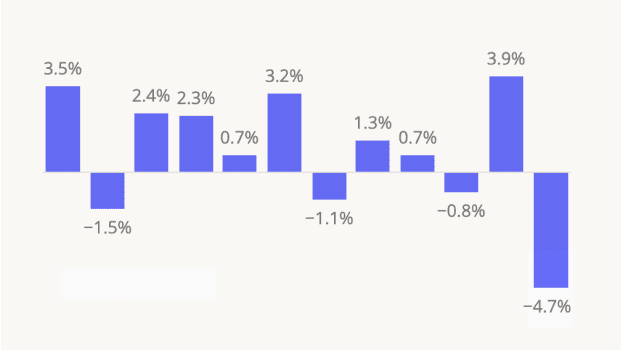The widespread adoption of hybrid work continues to be one of the most significant paradigm shifts since the COVID pandemic. As employees visit offices less frequently, or not at all, corporate users are opting for less but better space which is driving office vacancy rates to record highs.
But even as utilization for many office buildings remains below capacity, some buildings are clearly prospering. So what sets these thriving properties apart from the pack? We looked at outperforming office buildings in four major metro areas – New York, Chicago, San Francisco, and Dallas – to find out.
Buildings where Visits Exceed 2019 Levels
The post-pandemic office recovery has been uneven across the country. As of February 2024, a significantly larger share of workers in the New York-Newark-Jersey City and Dallas-Fort Worth CBSAs were back in the office, while office visits in the Chicago-Naperville-Elgin and San Francisco-Oakland-Berkeley CBSAs remained subdued.
But throughout the country, the reality is much more nuanced as some office buildings struggle to maintain occupancy,others are thriving. We identified four office buildings in four major metropolitan areas where the recovery in utilization was significantly stronger than the respective metro:
What sets these buildings apart from the pack?

Similar Visit Patterns in High-Occupancy Office Buildings
One factor that isn’t driving the office recovery at these high-occupancy office buildings is different weekly visitation patterns.
Location intelligence for offices nationwide indicates that hybrid workers appear to prefer coming to the office mid-week: The bulk of weekly visits occur on Tuesdays, Wednesdays, and Thursdays, with fewer visits taking place on Monday and even less visits on Fridays. And this was also the weekly visitation pattern in the four CBSAs analyzed as well as in the high-occupancy office buildings. In fact, the outperforming office buildings had even more of their visits concentrated mid-week compared to the visit patterns in the wider CBSA.

It seems, then, that the higher visits to these outperforming offices is not due to more employees coming in on typical WFH days. Instead, more workers are likely coming in mid-week to make up for the lull on Mondays and Fridays.
So who are these visitors? And could they hold the key to these buildings' strong recovery numbers?
High-Occupancy Office Buildings Draw Visitors From Areas with Higher Income & Fewer Families
Focusing on the period between March 2023 and February 2024 reveals that in all the labor catchment areas of the analyzed Office Indexes, the share of one-person households was larger than the nationwide share of 27.5%. And during the same period, the share of one-person households in the catchment areas of the high-performing office buildings was even greater – almost 50% of households in the captured market of 2010 Flora St. in Dallas consisted of one-person households.
On the other hand, families with children were underrepresented in the catchment areas of the office indexes relative to the nationwide average of 27.1% – and the share of households with children was even lower in the catchment areas of the high-occupancy office buildings.
This indicates that those with young children at home were generally less likely to go into the office – and so the office buildings seeing the strongest post-COVID recovery are those that serve a large contingent of single employees. On the flip side, there is often a motivation for young singles to visit the office more frequently, whether driven by the desire for training and mentorship or the prospect of meeting a significant other in or around the workplace.

Much has been written on the challenging impact that return-to-office mandates can have on working parents – and especially on working mothers – so it may not come as a surprise that employees from family households are underrepresented in office buildings in 2024.
But the fact that one-person households are even more prevalent in the labor markets of the overperforming buildings (as compared to the wider CBSA Office Index) indicates that businesses and office assets can thrive even without wooing working parents back to the office.
Outperforming Office Buildings See Larger Share of Visits from Managers & Executives
So who are these singles driving the return to the office? Some of this segment may be made up of Gen-Zers seeking the networking and mentorship opportunities provided by an in-person office setting. But it’s not just younger workers leading the return to the office – the data indicates that executives and managers also make up an outsized portion of the outperforming buildings’ catchment areas. In all four CBSAs analyzed, the catchment area of the high-occupancy building included a significantly larger share of people in a managerial or executive role compared to the average catchment area composition of the wider CBSA Office Index.
Many of these executives are likely choosing – rather than being forced – to work on-site. Some might be looking to encourage their staff to return to the office by leading by example, while many are likely leveraging their space to host clients, driving foot traffic to these locations higher. But whatever factors are driving the trend – it appears that office buildings looking to bounce back in the new normal need to make sure they are drawing back the managerial ranks.

Overperforming Offices Serve More Finance & Tech Workers
Analyzing the popular industries and occupations in the catchment areas of the office buildings and industries also reveals that the overperforming buildings serve a much higher share of employees working in finance, insurance, and real estate. A larger share of the catchment area population of the high-occupancy office complexes also works in professional services – including high-tech jobs – compared to the office index in the wider CBSA.

Many financial institutions and tech companies have asked employees to return to the office at least three days a week, which could explain why these industries are overrepresented in the catchment area of the high-occupancy buildings. This data may indicate, then, that while some of the foot traffic is coming from executives choosing to return to their pre-COVID work habits, the return-to-office mandates – whether full or part-time – are likely also helping these buildings stay ahead of the curve.
Return to Office Story Still Being Written
Although the proliferation of office vacancies across the country can make it seem like the return to office battle has already been lost, several buildings are bucking the trend. Location intelligence indicates that a combination of partial return-to-office mandates along with a larger-than-usual share of visitors from executives and non-parental households is helping these office complexes thrive.




.svg)





.png)
.png)

.png)
.png)









